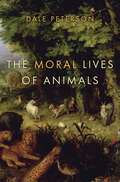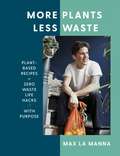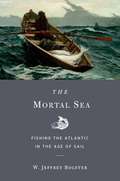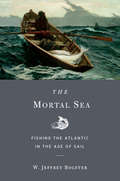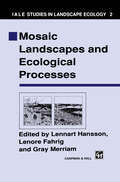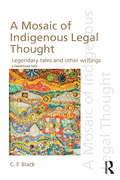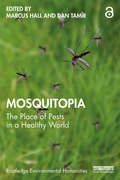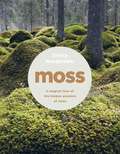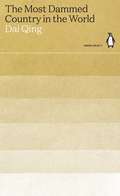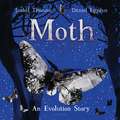- Table View
- List View
Moorland Matters: The Battle for the Uplands against Authoritarian Conservation
by Ian CoghillWith Britain’s islands holding more than three-quarters of the Earth’s stock of heather moorland, it is an extraordinary fact that it stands as one of the world’s rarest habitats.A landscape beloved by millions, it’s renowned for the tranquility and solace it provides – however, this tranquility is an illusion. Britain’s moorlands have, in less than a decade, moved from a position of benign consensus to the epicentre of the bitterest conflict within UK conservation.This insightful book sets out to examine and expose the hidden issues surrounding UK moorland conservation, giving a voice to the many people who work and live there and who feel that what they have to say is often ignored, if it’s even heard at all.The fate of our uplands are in our hands, and it is important that an alternative narrative, from the perspective of the practitioners who have cared for these places for generations, are considered.It may be that those with power chose to ignore these facts and sweep them away, but at least now they cannot say they didn’t know.
The Moral Lives of Animals
by Dale PetersonWild elephants walking along a trail stop and spontaneously try to protect and assist a weak and dying fellow elephant. Laboratory rats, finding other rats caged nearby in distressing circumstances, proceed to rescue them. A chimpanzee in a zoo loses his own life trying to save an unrelated infant who has fallen into a watery moat. The examples above and many others, argues Dale Peterson, show that our fellow creatures have powerful impulses toward cooperation, generosity, and fairness. Yet it is commonly held that we Homo sapiens are the only animals with a moral sense-that we are somehow above and apart from our fellow creatures. This rigorous and stimulating book challenges that notion, and it shows the profound connections-the moral continuum-that link humans to many other species. Peterson shows how much animal behavior follows principles embodied in humanity's ancient moral codes, from the Ten Commandments to the New Testament. Understanding the moral lives of animals offers new insight into our own.
Moral Responsibility and Risk in Society: Examples from Emerging Technologies, Public Health and Environment (Earthscan Risk in Society)
by Jessica Nihlén FahlquistRisks, including health and technological, attract a lot of attention in modern societies, from individuals as well as policy-makers. Human beings have always had to deal with dangers, but contemporary societies conceptualise these dangers as risks, indicating that they are to some extent controllable and calculable. Conceiving of dangers in this way implies a need to analyse how we hold people responsible for risks and how we can and should take responsibility for risks. Moral Responsibility and Risk in Society combines philosophical discussion of different concepts and notions of responsibility with context-specific applications in the areas of health, technology and environment. The book consists of two parts addressing two crucial aspects of risks and responsibility: holding agents responsible, i.e. ascribing and distributing responsibility for risks, and taking responsibility for risk. More specifically, the book discusses the values of fairness and efficacy in responsibility distributions and makes distinctions between backward-looking and forward-looking responsibility as well as individual and collective responsibility. Additionally, it analyses what it means to take responsibility for technological risks, conceptualising this kind of responsibility as a virtue, and furthermore, explores the notion of responsible risk communication and the implications for adult-child relationships. This book will be of great interest to students and scholars of environmental ethics, bioethics, public health ethics, engineering ethics, philosophy of risk and moral philosophy.
Moral Responsibility and Risk in Society: Examples from Emerging Technologies, Public Health and Environment (Earthscan Risk in Society)
by Jessica Nihlén FahlquistRisks, including health and technological, attract a lot of attention in modern societies, from individuals as well as policy-makers. Human beings have always had to deal with dangers, but contemporary societies conceptualise these dangers as risks, indicating that they are to some extent controllable and calculable. Conceiving of dangers in this way implies a need to analyse how we hold people responsible for risks and how we can and should take responsibility for risks. Moral Responsibility and Risk in Society combines philosophical discussion of different concepts and notions of responsibility with context-specific applications in the areas of health, technology and environment. The book consists of two parts addressing two crucial aspects of risks and responsibility: holding agents responsible, i.e. ascribing and distributing responsibility for risks, and taking responsibility for risk. More specifically, the book discusses the values of fairness and efficacy in responsibility distributions and makes distinctions between backward-looking and forward-looking responsibility as well as individual and collective responsibility. Additionally, it analyses what it means to take responsibility for technological risks, conceptualising this kind of responsibility as a virtue, and furthermore, explores the notion of responsible risk communication and the implications for adult-child relationships. This book will be of great interest to students and scholars of environmental ethics, bioethics, public health ethics, engineering ethics, philosophy of risk and moral philosophy.
The Moray Way Companion: A Comprehensive Guide to The Dava Way, The Moray Coast Trail and the Speyside Way
by Norman ThomsonThe Moray Way consists of all or part of three previously existing routes: the Moray Coast Trail, the Speyside Way and the Dava Way. Together they cover a huge and varied range of landscapes.This book is the ideal guide to much of what this beautiful and richly historical part of Scotland has to offer.The largest town, Forres, is an ancient royal burgh. Between it and the next biggest town of Lossiemouth lie the coastal villages of Findhorn, Burghead and Hopeman, connected by some of Scotland’s finest coastal scenery and beaches.Eastwards, beyond intact remains of second world war defences, lie Garmouth and Fochabers, the former, many centuries ago, the main port of Moray Here the Moray Way turns south, following a course through the fertile Spey valley. Its many distilleries are part of the considerable variety of interest as the route continues to the resort town of Grantown. A final stage northward crosses the wild openness of Dava Moor, reaching eventually the spectacular Divie viaduct where there is a dramatic change to gentler woodlands and pastoral landscapes as the trail leads back to Forres.
More Plants Less Waste: Plant-based Recipes + Zero Waste Life Hacks with Purpose
by Max La MannaMax La Manna, zero waste chef and sustainability advocate, bridges the gap between vegan food and waste-free cooking - inviting us to channel the MORE PLANTS LESS WASTE mindset and discover a stronger purpose in our daily routines. --Max has inspired thousands of people across the world to rethink their approach to consumption and made it his mission to turn the tide on plastic and breathe new energy into the leftovers that are typically destined for the bin. In his first cookbook he will share 80 of his tasty, healthy recipes that will have your taste buds watering, help you save money, food and eat well from Sumptuous Spag Bol and Crunchy Cauliflower Curry to Leftover Veggie Nachos in a Hurry.. MORE PLANTS->LESS WASTE INCLUDES: - simple, accessible ingredients that celebrate the power of plants and wholefoods at their best- all-natural home hacks from DIY deodorant to Citrus Bomb House Cleanser - the life tools you need to add value to what you already own and set you on the path to living more sustainably - a 21-day zero waste challenge--With a little more thought we can all make small changes that will have a BIG, positive impact on the health of our planet. --
More-than-One Health: Humans, Animals, and the Environment Post-COVID (Routledge Studies in Environment and Health)
by Irus BravermanThis edited volume examines the complex entanglements of human, animal, and environmental health. It assembles leading scholars from the humanities, social sciences, natural sciences, and medicine to explore existing One Health approaches and to envision a mode of health that is both more-than-human and also more sensitive to, and explicit about, colonial and neocolonial legacies—urging the decolonization of One Health. While acknowledging the importance of One Health, the volume at the same time critically examines its roots, highlighting the structural biases and power dynamics still at play in this global health regime. The volume is distinctive in its geographic breadth. It travels from Inuit sled dogs in the Arctic to rock hyraxes in Jerusalem, from black-faced spoonbills in Taiwan to street dogs in India, from spittle-bugs on Mallorca’s almond trees to jellyfish management at sea, and from rabies in sub-Saharan Africa to massive culling practices in South Korea. Together, the contributors call for One Health to move toward a more transparent, plural, and just perception of health that takes seriously the role of more-than-humans and of nonscientific knowledges, pointing to ways in which One Health can—and should—be decolonized. This volume will appeal to researchers and practitioners in the medical humanities, posthumanities, environmental humanities, science and technology studies, animal studies, multispecies ethnography, anthrozoology, and critical public health.
More-than-One Health: Humans, Animals, and the Environment Post-COVID (Routledge Studies in Environment and Health)
by Irus BravermanThis edited volume examines the complex entanglements of human, animal, and environmental health. It assembles leading scholars from the humanities, social sciences, natural sciences, and medicine to explore existing One Health approaches and to envision a mode of health that is both more-than-human and also more sensitive to, and explicit about, colonial and neocolonial legacies—urging the decolonization of One Health. While acknowledging the importance of One Health, the volume at the same time critically examines its roots, highlighting the structural biases and power dynamics still at play in this global health regime. The volume is distinctive in its geographic breadth. It travels from Inuit sled dogs in the Arctic to rock hyraxes in Jerusalem, from black-faced spoonbills in Taiwan to street dogs in India, from spittle-bugs on Mallorca’s almond trees to jellyfish management at sea, and from rabies in sub-Saharan Africa to massive culling practices in South Korea. Together, the contributors call for One Health to move toward a more transparent, plural, and just perception of health that takes seriously the role of more-than-humans and of nonscientific knowledges, pointing to ways in which One Health can—and should—be decolonized. This volume will appeal to researchers and practitioners in the medical humanities, posthumanities, environmental humanities, science and technology studies, animal studies, multispecies ethnography, anthrozoology, and critical public health.
The Mortal Sea: Fishing The Atlantic In The Age Of Sail
by W. Jeffrey BolsterSince the time of the Vikings, the Atlantic has shaped the lives of people who depend on it for survival, and people have shaped the Atlantic. In his account of this interdependency, Bolster, a historian and professional seafarer, takes us through a millennium-long environmental history of our impact on one of the largest ecosystems in the world.
The Mortal Sea: Fishing The Atlantic In The Age Of Sail
by W. Jeffrey BolsterSince the time of the Vikings, the Atlantic has shaped the lives of people who depend on it for survival, and people have shaped the Atlantic. In his account of this interdependency, Bolster, a historian and professional seafarer, takes us through a millennium-long environmental history of our impact on one of the largest ecosystems in the world.
Mortgaging the Earth: The World Bank, Environmental Impoverishment, and the Crisis of Development
by Bruce RichCalled a “detailed and thought-provoking look at an important subject” by The New York Times, Mortgaging the Earth analyzes the twenty year period leading up the 1992 Rio Summit. Rich offers not only an important history but critical insights about economic development that are ever-more relevant today.
Morton Deutsch: A Pioneer In Developing Peace Psychology (SpringerBriefs on Pioneers in Science and Practice #30)
by Peter T. Coleman Morton DeutschCommemorating Morton Deutsch’s 95th birthday, this book presents ten major texts by this highly respected social psychologist on war and peace. This first volume presents Deutsch in his role as a leading social science activist on issues of war and peace – writing papers, making speeches and participating in demonstrations. After serving in the U.S. Air Force during World War II and being awarded two Distinguished Flying Cross medals, as a psychologist he was determined to work for a more peaceful world. Influenced by Kurt Lewin, who believed that nothing was as practical as a good theory, Deutsch pursued theoretical work on such issues as cooperation-competition, conflict resolution and social justice with regard to issues of war and peace. As President of the Society for the Study of Peace, Conflict and Violence, the Society for the Psychological Study of Social Issues and the International Society of Political Psychology, he helped to foster social science efforts to make for a more peaceful world.
Morton Deutsch: Major Texts On Peace Psychology (SpringerBriefs on Pioneers in Science and Practice #31)
by Peter T. Coleman Morton DeutschCommemorating Morton Deutsch’s 95th birthday, this book presents ten major texts by this highly respected social psychologist on war and peace. This second volume presents Deutsch in his role as a leading social science activist on issues of war and peace – writing papers, making speeches and participating in demonstrations. After serving in the U.S. Air Force during World War II and being awarded two Distinguished Flying Cross medals, as a psychologist he was determined to work for a more peaceful world. Influenced by Kurt Lewin, who believed that nothing was as practical as a good theory, Deutsch pursued theoretical work on such issues as cooperation-competition, conflict resolution and social justice with regard to issues of war and peace. As President of the Society for the Study of Peace, Conflict and Violence, the Society for the Psychological Study of Social Issues and the International Society of Political Psychology, he helped to foster social science efforts to make for a more peaceful world.
Mosaic Landscapes and Ecological Processes
by L. Hansson L. Fahrig G. MerriamThis series presents studies that have used the paradigm of landscape ecology. Other approaches, both to landscape and landscape ecology are common, but in the last decade landscape ecology has become distinct from its predecessors and its contemporaries. Landscape ecology addresses the relationships among spatial patterns, temporal patterns and ecological processes. The effect of spatial configurations on ecological processes is fundamental. When human activity is an important variable affecting those relationships, landscape ecology includes it. Spatial and temporal scales are as large as needed for comprehension of system processes and the mosaic included may be very heterogeneous. Intellec tual utility and applicability of results are valued equally. The Inter national Association for Landscape Ecology sponsors this series of studies in order to introduce and disseminate some of the new knowledge that is being produced by this exciting new environmental science. Gray Merriam Ottawa, Canada Foreword This is a book about real nature, or as close to real as we know - a nature of heterogeneous landscapes, wild and humanized, fine-grained and coarse-grained, wet and dry, hilly and flat, temperate and not so temper ate. Real nature is never uniform. At whatever spatial scale we examine nature, we encounter patchiness. If we were to look down from high above at a landscape of millions of hectares, using a zoom lens to move in and out from broad overview to detailed inspection of a square meter we would see that patterns visible at different scales overlay one another.
A Mosaic of Indigenous Legal Thought: Legendary Tales and Other Writings
by C.F. BlackThis book offers an Indigenous supplement to the rich and growing area of visual legal scholarship. Organized around three narratives, each with an associated politico-poetic reading, the book addresses three major global issues: climate change, the trade in human body parts and bio-policing. Manifesting and engaging the traditional storytelling mode of classical Indigenous ontology, these narratives convey legal and political knowledge, not merely through logical argument, but rather through the feelings of law and the understanding of lawful behaviour produced by their rhythm. Through its own performativity, therefore, the book demonstrates how classical Indigenous legal traditions remain vital to the now pressing challenge of making peace with the earth.
A Mosaic of Indigenous Legal Thought: Legendary Tales and Other Writings
by C.F. BlackThis book offers an Indigenous supplement to the rich and growing area of visual legal scholarship. Organized around three narratives, each with an associated politico-poetic reading, the book addresses three major global issues: climate change, the trade in human body parts and bio-policing. Manifesting and engaging the traditional storytelling mode of classical Indigenous ontology, these narratives convey legal and political knowledge, not merely through logical argument, but rather through the feelings of law and the understanding of lawful behaviour produced by their rhythm. Through its own performativity, therefore, the book demonstrates how classical Indigenous legal traditions remain vital to the now pressing challenge of making peace with the earth.
Mosaics Inspired by Nature: Creating Contemporary Art
by Rachel DaviesA creative guide to making abstract mosaic designs inspired by nature, using the beauty and texture of slate and stone.The shapes, patterns and structures found in the natural world can provide a source of wonder and inspiration for mosaic artists. Mosaics do not have to be made from tiles and then grouted, but instead they can be full of texture, incorporating a whole array of materials which hold connections to nature and to particular places. The subtle beauty of stone surfaces gives the work an organic feel, creating beautiful abstract designs. Not only are these materials attractive but preparing them is an enjoyable task in itself. In this book, experienced artist Rachel Davies shares the methods she uses in her mosaic practice. Starting with tools, materials and cutting techniques, discover adhesive and substrate options, and get to know the various materials and how to use them creatively. Supported by step-by-step photos, follow a series of exercises and suggestions to explore your interests and develop your own designs. With a focus on three of her own mosaics, inspired by seaweed, lichen and bark, Rachel walks you through her process to show how a piece of art develops from start to finish. Beautifully illustrated with photographs of Rachel's own work as well as spotlights on seven other contemporary artists, find inspiration and get started on your own mosaic journey.
Mosaics Inspired by Nature: Creating Contemporary Art
by Rachel DaviesA creative guide to making abstract mosaic designs inspired by nature, using the beauty and texture of slate and stone.The shapes, patterns and structures found in the natural world can provide a source of wonder and inspiration for mosaic artists. Mosaics do not have to be made from tiles and then grouted, but instead they can be full of texture, incorporating a whole array of materials which hold connections to nature and to particular places. The subtle beauty of stone surfaces gives the work an organic feel, creating beautiful abstract designs. Not only are these materials attractive but preparing them is an enjoyable task in itself. In this book, experienced artist Rachel Davies shares the methods she uses in her mosaic practice. Starting with tools, materials and cutting techniques, discover adhesive and substrate options, and get to know the various materials and how to use them creatively. Supported by step-by-step photos, follow a series of exercises and suggestions to explore your interests and develop your own designs. With a focus on three of her own mosaics, inspired by seaweed, lichen and bark, Rachel walks you through her process to show how a piece of art develops from start to finish. Beautifully illustrated with photographs of Rachel's own work as well as spotlights on seven other contemporary artists, find inspiration and get started on your own mosaic journey.
Mosquitopia: The Place of Pests in a Healthy World (Routledge Environmental Humanities)
by Marcus Hall Dan TamïrThis edited volume brings together natural scientists, social scientists and humanists to assess if (or how) we may begin to coexist harmoniously with the mosquito. The mosquito is humanity’s deadliest animal, killing over a million people each year by transmitting malaria, yellow fever, Zika and several other diseases. Yet of the 3,500 species of mosquito on Earth, only a few dozen of them are really dangerous—so that the question arises as to whether humans and their mosquito foe can learn to live peacefully with one another. Chapters assess polarizing arguments for conserving and preserving mosquitoes, as well as for controlling and killing them, elaborating on possible consequences of both strategies. This book provides informed answers to the dual question: could we eliminate mosquitoes, and should we? Offering insights spanning the technical to the philosophical, this is the “go to” book for exploring humanity’s many relationships with the mosquito—which becomes a journey to finding better ways to inhabit the natural world. Mosquitopia will be of interest to anyone wanting to explore dependencies between human health and natural systems, while offering novel perspectives to health planners, medical experts, environmentalists and animal rights advocates.
Mosquitopia: The Place of Pests in a Healthy World (Routledge Environmental Humanities)
by MarcusDan Hall TamïrThis edited volume brings together natural scientists, social scientists and humanists to assess if (or how) we may begin to coexist harmoniously with the mosquito. The mosquito is humanity’s deadliest animal, killing over a million people each year by transmitting malaria, yellow fever, Zika and several other diseases. Yet of the 3,500 species of mosquito on Earth, only a few dozen of them are really dangerous—so that the question arises as to whether humans and their mosquito foe can learn to live peacefully with one another. Chapters assess polarizing arguments for conserving and preserving mosquitoes, as well as for controlling and killing them, elaborating on possible consequences of both strategies. This book provides informed answers to the dual question: could we eliminate mosquitoes, and should we? Offering insights spanning the technical to the philosophical, this is the “go to” book for exploring humanity’s many relationships with the mosquito—which becomes a journey to finding better ways to inhabit the natural world. Mosquitopia will be of interest to anyone wanting to explore dependencies between human health and natural systems, while offering novel perspectives to health planners, medical experts, environmentalists and animal rights advocates.
Moss
by Ulrica NordströmExplore the magical world of moss, with this fully-illustrated and comprehensive guide. Moss is all around us. While it is most often associated with damp, shady spaces, it can be found in the most unexpected and far-flung places, from deserts to Antarctica. This book is a celebration of its quiet, unassuming beauty and a primer to understanding the secrets of the world's most ancient plant: · Discover the fascinating history of this soft and tactile plant · Learn how and where to identify and gather different moss species.· Take a tour of some of the most beautiful moss gardens in the UK, the US and Japan, where moss viewing has become a national phenomenon.· Learn how to cultivate moss, tie Japanese moss balls (kokedama) and plant moss landscapes in pots and terrariums.With stunning photography and botanical illustration, this is an utterly unique book that will be treasured by plant enthusiasts of all kinds.
The Most Dammed Country in the World (Green Ideas)
by Dai QingIn twenty short books, Penguin brings you the classics of the environmental movement.The courageous, unflinching speeches and writings collected in The Most Dammed Country in the World detail the devastating human and environmental cost of China's economic rise.Over the past 75 years, a new canon has emerged. As life on Earth has become irrevocably altered by humans, visionary thinkers around the world have raised their voices to defend the planet, and affirm our place at the heart of its restoration. Their words have endured through the decades, becoming the classics of a movement. Together, these books show the richness of environmental thought, and point the way to a fairer, saner, greener world.
A Most Improbable Story: The Evolution of the Universe, Life, and Humankind
by Steven J. TherouxThis book is a "Big History" of the evidence regarding how we came to be. It briefly explores philosophical thought and how our past might affect our future. The text summarizes different perspectives, including the strengths and weaknesses of each. The genesis of our planet is explored, especially the circumstances that must exist for complex life to arise. This brief journey highlights the history of life, the emergence of simple lifeforms, and the evolution of complex creatures, including humans. The book concludes with a discussion of why other humanoids went extinct while our species achieved dominance. The author speculates on potentialities awaiting humankind and our planet. The first "Big History" written from the perspective of a biologist Summarizes multiple perspectives of history Documents the unique conditions for the emergence of life Speculates on the future
A Most Improbable Story: The Evolution of the Universe, Life, and Humankind
by Steven J. TherouxThis book is a "Big History" of the evidence regarding how we came to be. It briefly explores philosophical thought and how our past might affect our future. The text summarizes different perspectives, including the strengths and weaknesses of each. The genesis of our planet is explored, especially the circumstances that must exist for complex life to arise. This brief journey highlights the history of life, the emergence of simple lifeforms, and the evolution of complex creatures, including humans. The book concludes with a discussion of why other humanoids went extinct while our species achieved dominance. The author speculates on potentialities awaiting humankind and our planet. The first "Big History" written from the perspective of a biologist Summarizes multiple perspectives of history Documents the unique conditions for the emergence of life Speculates on the future
Moth
by Isabel ThomasPowerful and visually spectacular, Moth is the remarkable evolution story that captures the struggle of animal survival against the background of an evolving human world in a unique and atmospheric introduction to Darwin's theory of Natural Selection.“This is a story of light and dark…”Against a lush backdrop of lichen-covered trees, the peppered moth lies hidden. Until the world begins to change...Along come people with their magnificent machines which stain the land with soot. In a beautiful landscape changed by humans how will one little moth survive?A clever picture book text about the extraordinary way in which animals have evolved, intertwined with the complication of human intervention. This remarkable retelling of the story of the peppered moth is the perfect introduction to natural selection and evolution for children.

